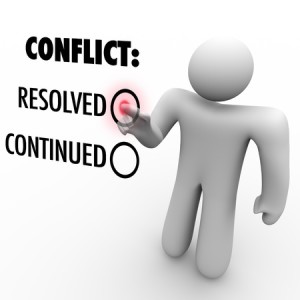By Rose O. Sherman, EdD, RN, NEA-BC, FAAN
 I hate conflict, a manager recently told me. Her goal is to make her unit a conflict-free zone. This is a worthy goal but probably not doable I warned her. We know from the work of Patrick Lencioni that the inability to effectively deal with conflict is one of five dysfunctions seen in teams who don’t work well together. When teams avoid or don’t discuss the conflicts they have with one another then it jeopardizes psychological safety which is key to effective teamwork.
I hate conflict, a manager recently told me. Her goal is to make her unit a conflict-free zone. This is a worthy goal but probably not doable I warned her. We know from the work of Patrick Lencioni that the inability to effectively deal with conflict is one of five dysfunctions seen in teams who don’t work well together. When teams avoid or don’t discuss the conflicts they have with one another then it jeopardizes psychological safety which is key to effective teamwork.
Guiding your team members to get past their day to day problems, conflicts and communication issues toward a goal of working as a high-performance work team can be a significant leadership challenge. Yet, nowhere are the stakes higher than in health care, where team synergy and interdependence are required for high-quality patient outcomes. Conflict is central to all interactions because of the diversity of human experience. But in leadership, it can also be very time-consuming.
Where conflict was once thought of as a bad thing, we now realize that it can help us to grow and reach the common ground more quickly if we manage it well. It can serve as a positive driving force for change and improvement. Conflict is usually driven by different values and beliefs about situations roles and positions. Conflict can be negative when egos are attached, people are hurt and solutions are not found or when the conflict is ignored.
Strategies for Nurse Leaders
To more effectively manage conflict, there are some key things to consider:
Your own conflict management style – Not everyone manages conflict in the same way. Although many of us can flex our style when needed, we usually have a preferred style of managing conflict which is important to identify. According to the widely used Thomas Kilmann model of conflict resolution, there are five primary styles of conflict resolution: Avoiding, Accommodating, Competing, Collaboration and Compromising. In workshops I have done with nurse leaders, the primary style for many is avoiding. While in some situations this could be the right approach, it will be problematic in most conflict situations. It is beneficial to take an assessment and learn more about your own style
The background issues that drive the conflict – Experts contend that there are always antecedents to any conflict situation. Before a leader intervenes in a conflict, they need to accurately assess how it occurred. The antecedent conditions are what started the conflict. An example of this could be that the charge nurse changes the assignment of staff nurses during the shift because of issues with patient throughput. This can then lead to perceived conflict if the staff nurse disagrees with the change. This is different than getting each team member’s version of events. Diagnosing system or personal issues that led to a conflict that could be important to consider in resolution. There are times that staff has had close personal relationships in the past that can play a role in the conflict.
Is it escalating or being managed effectively – Not every conflict needs to be managed yet some do escalate very quickly. How you resolve a conflict involving a patient’s family member knowing the patient will be discharged tomorrow will be different than the conflict between two members who need to work together.
When, Where and How to Take Appropriate Action – Conflict mediation is a skill set that all leaders need to develop. To be effective especially in escalating situations, it needs to be intentional and specific steps need to be followed. The right location to have a discussion needs to considered and the conflict defined. Ground rules need to be set including desired outcomes. Each side needs to tell their story. Alternatives need to be discussed and an agreeable strategy needs to be selected. In unionized environments, the staff member may be entitled to have a union representative present.
Developing your conflict management skills is like building a muscle. The more you do it, the more effective you will be. As challenging as the conflict is, unresolved conflict can come at a very high cost. Unresolved disputes often lead to a loss of productivity as those involved draw others into their drama. It can lead to the turnover of valuable employees. The competition that can be an outcome of conflict has a very negative impact on team relationships. Those involved in conflict often pay a heavy price in terms of their own personal health leading to things like depression, anxiety, and loss of sleep. The biggest losers in unresolved conflict are often patients because conflict leads to communication issues that directly impact the quality of patient care.
Read Rose Sherman’s new book – The Nurse Leader Coach: Become the Boss No One Wants to Leave
Read to Lead
Lencioni, P. (2002). The five dysfunctions of a team. San Francisco: Jossey-Bass.
© emergingrnleader.com 2019


 LinkedIn
LinkedIn Instagram
Instagram